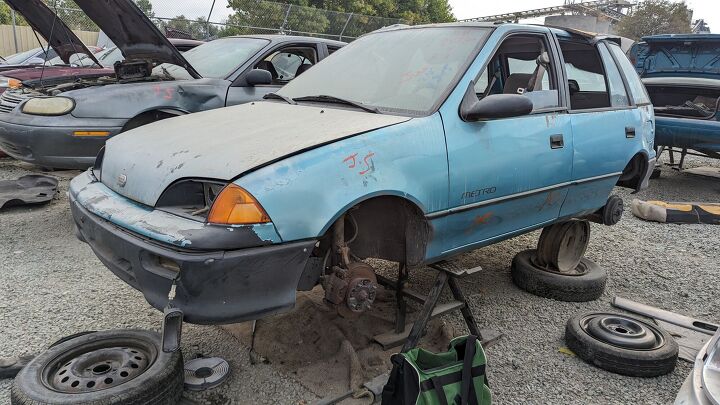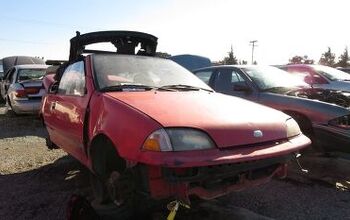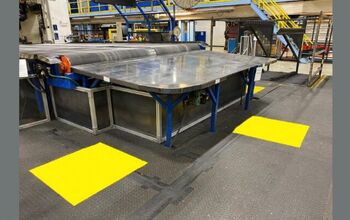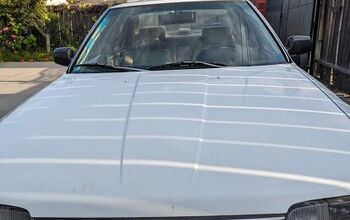Junkyard Find: 1992 Geo Metro 4-door hatchback

What was the cheapest new four-door car available in the United States for the 1992 model year? Not the Subaru Justy, not the Toyota Tercel, not the Hyundai Excel and not the Suzuki Swift. It was today's Junkyard Find!
Yes, the base-model 1992 Geo Metro four-door (or five-door, if that's your preferred nomenclature) hatchback had an MSRP of just $7,399. That's $16,435 in 2024 dollars, which says a lot about how much more you get with the cheapest available new four-door right now.
Oh, sure, buyers willing to live with a two-door could go cheaper than this car in 1992; a new Yugo GV listed at… well, it's hard to say, given that the Yugo's homeland was busy with its civil war and Yugo America Inc folded its tent early in the year; the latest trustworthy Yugo MSRP I could find in my reference library was $4,435 for the base 1990 model ($10,678 in 2024 dollars).
If we're talking about realistic Metro competitors here, the base 1992 Ford Festiva actually managed to undercut the price tag on the cheapest possible Metro two-door hatchback that year: $6,911 versus $6,999.
The wretched 1992 Hyundai Excel base two-door was even cheaper, at $6,595 ($15,879 in today's spondoolies). The cheapest 1992 Subaru Justy was $6,445, and Subaru likely could have squeezed a four-door under the Metro's cost if it hadn't insisted on selling all its U.S.-market four-door Justys with four-wheel-drive by that time.
Those reviewers who whine about the Mitsubishi Mirage's lack of horsepower (I say it's a good-enough car with an excellent warranty for the money, or at least the last one I reviewed was) should consider the engine in this car.
That's one liter (actually 0.993 liters) of displacement from three rampaging cylinders, rated at 55 horsepower and 58 pound-feet. The good news is that it has electronic fuel injection and an overhead camshaft.
Even better news during a time of recession in California (which is where I found this car) is the fuel economy it delivered with a five-speed manual transmission: 40 miles per gallon on the highway, 38 miles per gallon in the city. You could get the Geo Metro with an automatic, and I've found exactly one during my junkyard travels (and that includes EV conversions).
The Metro was based on the second-generation Suzuki Cultus, and it was the successor to the 1985-1988 Chevrolet Sprint (which was based on the first-generation Cultus). You could buy versions of this car all the way through 2017 in Pakistan.
Suzuki began selling the Cultus with Swift badges in the United States as a 1989 model, though Swift prices were always a bit higher than Metro prices.
This car was built at the CAMI plant in Ontario, where Geo Trackers and Suzuki Sidekicks were born in order to circumvent the Chicken Tax.
The Metro entered its second generation as a 1995 model, when the Cultus entered its third generation. It became the Chevrolet Metro starting with the 1998 model year, due to the Geo brand getting axed by The General in 1997.
Production of the Chevrolet Metro continued through 2001, after which it was replaced by the Suzuki Aerio and the Daewoo-built Chevrolet Aveo. Such is the nature of the mighty GM Empire.
This car has a Delco AM/FM/cassette radio, which added $441 to the bottom line ($980 now). Amazingly, the right-side mirror was included at no extra cost on all 1992 Metro models except the gas-mileage-king XFi. I suspect that the radio was a junkyard-obtained unit swapped in long after purchase, since body parts have been swapped as well.
The five-digit odometer means we can't know the true final mileage. My guess is that the reels turned over once, for a total of 162,150.9 miles during this car's life on the road (the kind of owners who can get cars to intergalactic odometer readings generally don't allow their rides to get as hooptiefied as this one, though I have seen exceptions to that rule).
Gas was cheap during the late 1980s and early 1990s, other than a spike after Iraq invaded Kuwait, but some car buyers still wanted good fuel economy.
Gets 100 kilometers per 4.5 liters of gasoline on the Canadian highway. In 1994, the General switched back to the Firefly name that had gone on his Canadian-market Chevy Sprints.
In Japan, the second-gen Cultus made you hip-conscious.
Like a jean, whatever that means.
PLAY CULTUS.
Down Under, this car was known as the Holden Barina, and it was available as a Sportsgirl Edition.
Baby, you can drive my Barina!
1992 Geo Metro base model in California wrecking yard.
1992 Geo Metro base model in California wrecking yard.
1992 Geo Metro base model in California wrecking yard.
1992 Geo Metro base model in California wrecking yard.
1992 Geo Metro base model in California wrecking yard.
1992 Geo Metro base model in California wrecking yard.
1992 Geo Metro base model in California wrecking yard.
1992 Geo Metro base model in California wrecking yard.
1992 Geo Metro base model in California wrecking yard.
1992 Geo Metro base model in California wrecking yard.
1992 Geo Metro base model in California wrecking yard.

Murilee Martin is the pen name of Phil Greden, a writer who has lived in Minnesota, California, Georgia and (now) Colorado. He has toiled at copywriting, technical writing, junkmail writing, fiction writing and now automotive writing. He has owned many terrible vehicles and some good ones. He spends a great deal of time in self-service junkyards. These days, he writes for publications including Autoweek, Autoblog, Hagerty, The Truth About Cars and Capital One.
More by Murilee Martin
Latest Car Reviews
Read moreLatest Product Reviews
Read moreRecent Comments
- Varezhka I have still yet to see a Malibu on the road that didn't have a rental sticker. So yeah, GM probably lost money on every one they sold but kept it to boost their CAFE numbers.I'm personally happy that I no longer have to dread being "upgraded" to a Maxima or a Malibu anymore. And thankfully Altima is also on its way out.
- Tassos Under incompetent, affirmative action hire Mary Barra, GM has been shooting itself in the foot on a daily basis.Whether the Malibu cancellation has been one of these shootings is NOT obvious at all.GM should be run as a PROFITABLE BUSINESS and NOT as an outfit that satisfies everybody and his mother in law's pet preferences.IF the Malibu was UNPROFITABLE, it SHOULD be canceled.More generally, if its SEGMENT is Unprofitable, and HALF the makers cancel their midsize sedans, not only will it lead to the SURVIVAL OF THE FITTEST ones, but the survivors will obviously be more profitable if the LOSERS were kept being produced and the SMALL PIE of midsize sedans would yield slim pickings for every participant.SO NO, I APPROVE of the demise of the unprofitable Malibu, and hope Nissan does the same to the Altima, Hyundai with the SOnata, Mazda with the Mazda 6, and as many others as it takes to make the REMAINING players, like the Excellent, sporty Accord and the Bulletproof Reliable, cheap to maintain CAMRY, more profitable and affordable.
- GregLocock Car companies can only really sell cars that people who are new car buyers will pay a profitable price for. As it turns out fewer and fewer new car buyers want sedans. Large sedans can be nice to drive, certainly, but the number of new car buyers (the only ones that matter in this discussion) are prepared to sacrifice steering and handling for more obvious things like passenger and cargo space, or even some attempt at off roading. We know US new car buyers don't really care about handling because they fell for FWD in large cars.
- Slavuta Why is everybody sweating? Like sedans? - go buy one. Better - 2. Let CRV/RAV rust on the dealer lot. I have 3 sedans on the driveway. My neighbor - 2. Neighbors on each of our other side - 8 SUVs.
- Theflyersfan With sedans, especially, I wonder how many of those sales are to rental fleets. With the exception of the Civic and Accord, there are still rows of sedans mixed in with the RAV4s at every airport rental lot. I doubt the breakdown in sales is publicly published, so who knows... GM isn't out of the sedan business - Cadillac exists and I can't believe I'm typing this but they are actually decent - and I think they are making a huge mistake, especially if there's an extended oil price hike (cough...Iran...cough) and people want smaller and hybrids. But if one is only tied to the quarterly shareholder reports and not trends and the big picture, bad decisions like this get made.


























































Comments
Join the conversation
1995 Geo Metro 3 door, 3 cyl, 4 wheels, ugliest blue ever made was the BEST car I've ever owned. Or maybe the best value. I bought mine used in 2005 with 50k miles for $1,00 from a friend of a friend. Had some scrapes on the doors from his wife having trouble parking in their apartment parking garage. But nothing else wrong. I drove it from 2005 until 2013 as my only car and only changed tires once, serviced front and rear brakes 1x, bought a new battery and changed the oil every 10k miles needed or not 😀.
I sold it with 197k miles, for $950 after 8 years. So I lost $50 depreciation, not including maintainance mentioned. In addition, I sold it because it finally crapped out. I think it was electrical, because I couldn't get it to turn over one day (or even TRY to turn) , and after having 2 buddies tell me, "Might be serious, but IDK" I posted it on CL and sold the next day.
Still has 1/2 a tank of GAS!!!